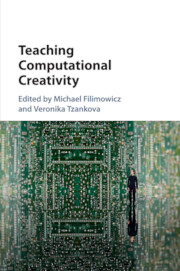Book contents
- Teaching Computational Creativity
- Teaching Computational Creativity
- Copyright page
- Contents
- Figures
- Tables
- Notes on Contributors
- Acknowledgments
- Introduction: Pedagogies at the Intersection of Disciplines
- PART I NEW FOUNDATIONS
- PART II CODE AS MEDIUM
- PART III PHYSICAL{LY} COMPUTING
- PART IV ONLINE LEARNING
- 7 Design Scenes of Online Code Learning Environments
- 8 Between Code and Culture: Developing a Creative Coding Massive Open Online Course
- PART V CRITICAL PEDAGOGY
- PART VI TRANSDISCIPLINARY
- Interviews
- Afterword: Toward a Curricular Synthesis
- Index
- References
8 - Between Code and Culture: Developing a Creative Coding Massive Open Online Course
from PART IV - ONLINE LEARNING
Published online by Cambridge University Press: 04 July 2017
- Teaching Computational Creativity
- Teaching Computational Creativity
- Copyright page
- Contents
- Figures
- Tables
- Notes on Contributors
- Acknowledgments
- Introduction: Pedagogies at the Intersection of Disciplines
- PART I NEW FOUNDATIONS
- PART II CODE AS MEDIUM
- PART III PHYSICAL{LY} COMPUTING
- PART IV ONLINE LEARNING
- 7 Design Scenes of Online Code Learning Environments
- 8 Between Code and Culture: Developing a Creative Coding Massive Open Online Course
- PART V CRITICAL PEDAGOGY
- PART VI TRANSDISCIPLINARY
- Interviews
- Afterword: Toward a Curricular Synthesis
- Index
- References
Summary
Since the rapid rise of the massive open online course (MOOC) in 2011, online learning has increased sharply. Various platforms such as Coursera, FutureLearn, and Udacity enable academics to develop and manage single courses that often enroll vast numbers of learners. These platforms provide a unique range of instruments for an academic to embed discipline knowledge and skills development into the course. In this chapter, the authors examine the MOOC they created for the FutureLearn platform called Creative Coding. They explore the historical contingencies through which algorithmic thinking and coding literacies are being ubiquified across various cultural spheres of activity and also the “technical and cultural prism” through which these literacies are filtered. These contingencies and literacies provided a framework for the production of the Creative Coding MOOC, which is discussed in the latter half of this chapter.
- Type
- Chapter
- Information
- Teaching Computational Creativity , pp. 191 - 210Publisher: Cambridge University PressPrint publication year: 2017



